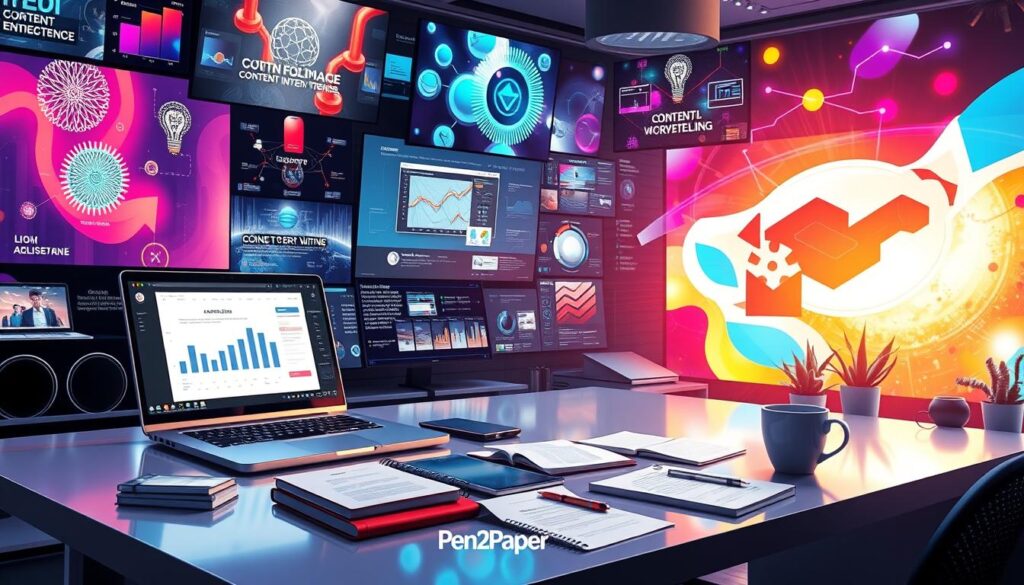Content writing is changing fast as the digital world grows. Pen2Pager, a top content creation agency, has found the main trends for the future. These include AI content creation and immersive tech, set to change content writing by 2025.

In this detailed article, we’ll look at the latest changes in content writing. By keeping up with these trends, writers can stay ahead. They can create amazing digital content that grabs people’s attention worldwide.
The Evolution of AI-Powered Content Creation
Content creation is changing fast, thanks to artificial intelligence (AI). Natural language processing has made a big difference. Now, AI tools help writers and marketers make great content quickly and easily.
Natural Language Processing Advancements
Natural language processing (NLP) has made huge strides. AI can now understand and create text that sounds like it was written by a person. This means AI tools can make content that really speaks to the audience.
Human-AI Collaboration Models
The best thing about AI content creation is when humans and machines work together. AI starts the content, but humans make it shine. This mix of human touch and AI power creates content that really hits the mark.
Quality Control in AI-Generated Content
As we use more AI content, keeping it high quality is key. We need to check and double-check the content. This ensures it’s right, relevant, and true to its word. It’s all about keeping the content trustworthy and reliable.
Voice Search Optimization in Content Writing
As voice search technology grows, content writers must change their ways. *Voice search* is changing how we talk to search engines. It’s key to make sure your content is easy to find with voice queries. A good *content strategy* that gets voice search is vital.
Understanding how people speak to search engines is crucial. Voice queries are often longer and more detailed. Writers should write in a way that answers these questions clearly and briefly.
Using long-tail keywords and conversational language can also help. This makes your content more visible in voice search results.
How you structure your content matters too. Using clear headings, bullet points, and schema markup helps search engines find what you’re talking about. This makes your content easier to find and read, not just for voice search.
Content Writing for Immersive Technologies
The digital world is changing fast, and content writers need to keep up. They must create experiences that feel real, thanks to virtual reality (VR) and augmented reality (AR). We’ll look at how to write for VR, add AR elements, and make content that grabs and inspires people.
Virtual Reality Content Strategies
Writing for VR is different. It’s about moving beyond the screen and into a 360-degree world. To make *immersive content* that feels real, writers need to understand how VR works and how to tell stories in space.
Augmented Reality Integration
AR is a new chance for writers to make the real world more interesting. By mixing *AR integration* with regular content, writers can make learning fun and interactive. This can be anything from showing off products to making learning fun with digital overlays.
Interactive Content Formats
Interactive content is also on the rise. *Interactive content formats* let people take part in the story, making it more personal and engaging. Writers are finding new ways to make stories that change based on what the audience does, like games or interactive stories.
Data-Driven Personalization Strategies
In today’s fast-changing world of content writing, making personalized content is key. Content writers use data analytics to create content that speaks to specific groups. This approach boosts user engagement and builds strong connections with the audience.
Using *user data*, writers can find out what their audience likes and needs. They look at page views, bounce rates, and how people interact with content. This helps them make content that meets each group’s unique interests.
Also, *predictive analytics* helps make personalization even better. By studying past data and user habits, writers can guess what content will interest their audience. This leads to more engagement and loyalty to the brand.
As more people want personalized content, writers who use data-driven strategies will stand out. They’ll create experiences that grab their audience’s attention and deliver real results.
Multilingual Content Optimization
In today’s global marketplace, creating and sharing multilingual content is key to success. As businesses grow worldwide, they must meet diverse language and cultural needs. This section looks at how to optimize multilingual content, helping businesses reach more people and grow globally.
Cultural Adaptation Techniques
Understanding your audience’s cultural nuances is the first step in optimizing multilingual content. Cultural adaptation techniques involve adjusting content, tone, and messaging for local tastes. This ensures a personalized experience for users.
By using cultural references and idioms, businesses can connect better with their global customers. This builds trust and strengthens relationships.
Translation Technology Integration
Advanced translation technology has changed how businesses create multilingual content. Tools like machine translation and human-assisted localization make the process faster and cheaper. They help maintain quality.
By using AI and human expertise, companies can create multilingual content that speaks to their global audience.
Global Content Distribution
After optimizing content, it’s time to share it worldwide. This means using the right channels and platforms for international users. A good strategy includes localized websites, mobile apps, and social media campaigns.
Conclusion
The digital world is changing fast, and content writing is no exception. AI, voice search, and immersive tech are leading the way. These trends will push content creators to be more innovative and adaptable.
Pen2Pager is at the forefront of these changes. They use the latest in AI and data to help businesses create engaging content. This content speaks to their audience in a meaningful way.
As the industry grows, writers and marketers must be open to new ideas. They need to lead the way in content writing’s future. By doing so, they can connect with their audience better and help their businesses thrive.
